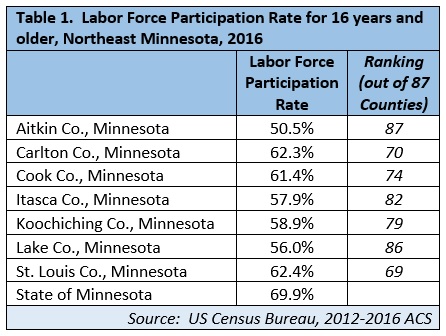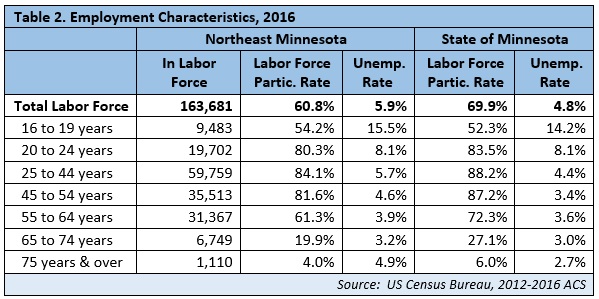 Home to the state's second-largest metro, the Northeast Region has a strong industrial sector, tied largely to the area's abundant natural resources.
Home to the state's second-largest metro, the Northeast Region has a strong industrial sector, tied largely to the area's abundant natural resources.
Most of the manufacturing base centers on mining and forest products industries. More than half of the sector's employment is in paper and machinery manufacturing.
Want the freshest data delivered by email? Subscribe to our regional newsletters.
8/1/2018 5:00:00 PM
Erik White
The labor force participation rate is a useful measure of economic activity. However, because of how it’s calculated, it’s important to be aware of how an older population can skew this statistic. The labor force participation rate includes the total number of people who are currently employed or actively seeking work, and does not include those who are not participating in the labor force. The measure is often referenced with the unemployment rate as an indicator of the health of the economy.
The numerator of the labor force participation rate is the number of employed and unemployed but actively seeking people; while the denominator is the total population aged 16 years and older, regardless of labor force status. This includes those that are older than 65 years, the traditional age of retirement. A geographic area with a greater portion of retirees will have a lower labor force participation rate: These people are not considered working nor actively seeking work. The Northeast region is home to more elderly residents, and the labor force participation rate reflects the fact that this older population is less likely to participate in the labor force.
Northeast Minnesota has some of the lowest labor force participation rates in the state when looking at the population 16 years and older. Aitkin County has a rate of 50.5 percent, which ranks last in all 87 Minnesota counties; and Lake County is ranked second to last with a labor force participation rate of 56.0 percent. For the Arrowhead region, St. Louis County has the highest labor force participation rate at 62.4 percent, but that is still considerably less than the state average of 69.9 percent, and ranked 69th out of 87 counties statewide (Table 1).

One way to control for an older population skewing the labor force participation rate is to calculate it for specific age cohorts. Instead of the denominator containing the total population that is 16 years and older, you can calculate it by including only those that are in a specific age cohort.
For example, the labor force participation rate for 16- to 19-year-olds in Northeast Minnesota is 54.2 percent, greater than for 16- to 19-year-olds statewide. Participation rates for 25- to 54-year-olds in the Arrowhead are greater than 80 percent, although that lags behind statewide rates for those particular age cohorts.
At the other end of the spectrum, the rate for 55- to 64-year-olds was 61.3 percent in the Arrowhead region, more than 10 percentage points lower than the statewide rate for this age cohort, and 20 percentage points less than the rate for younger age cohorts. The participation rate for people aged 65 years and older is also lower in the region than statewide, and suggests that people do come to the Arrowhead region to retire and enjoy the natural amenities (Table 2).

It’s important to consider how an older population affects the labor force participation rate of the region, especially when using that statistic as a measure of economic activity. While the data shows lower labor force participation in Northeast Minnesota, even when controlling for age, it also indicates opportunities to entice older citizens who retired early to jump back into the labor force and help alleviate the tight labor market conditions.
Contact Erik White at 218-302-8413.